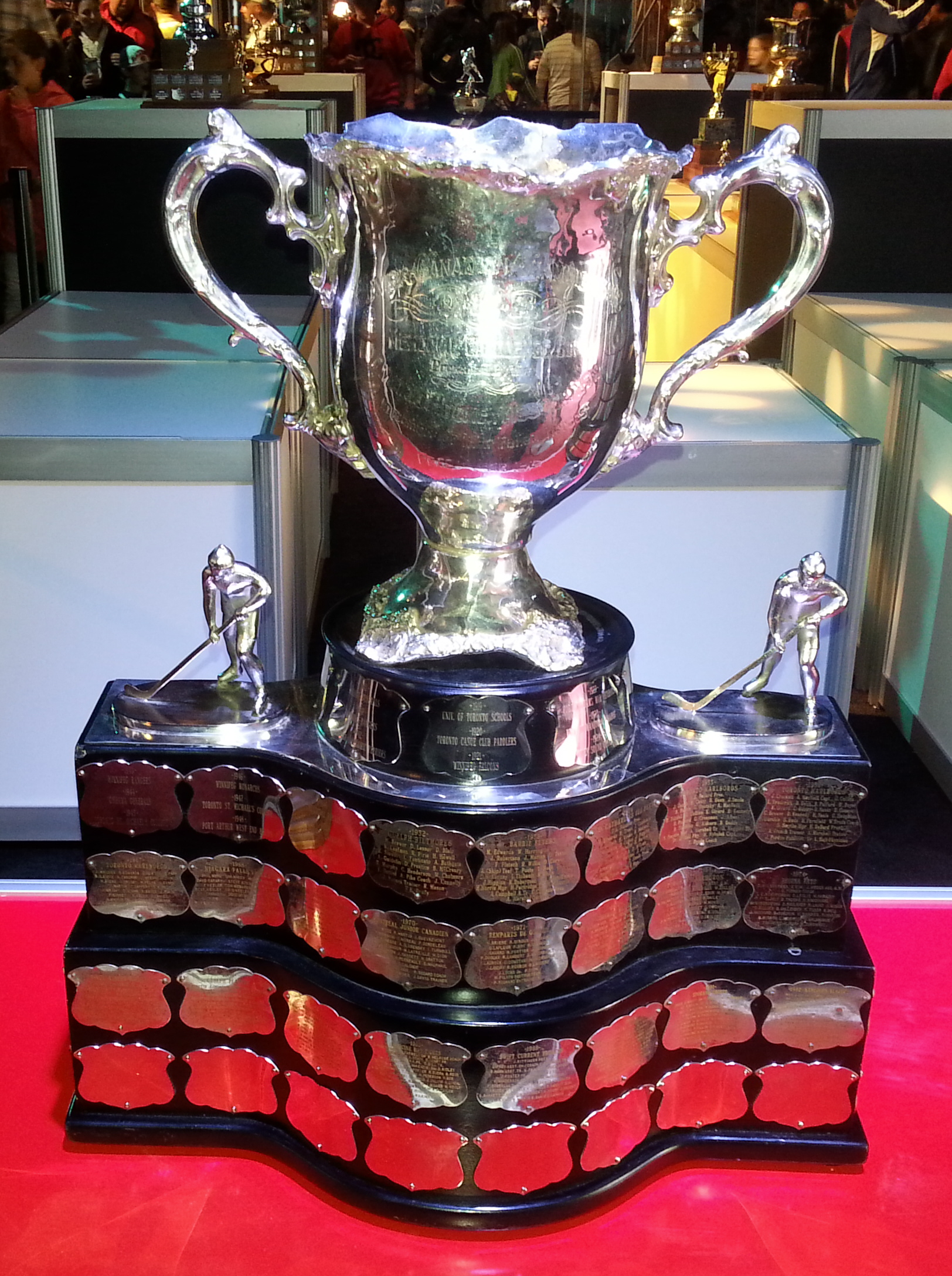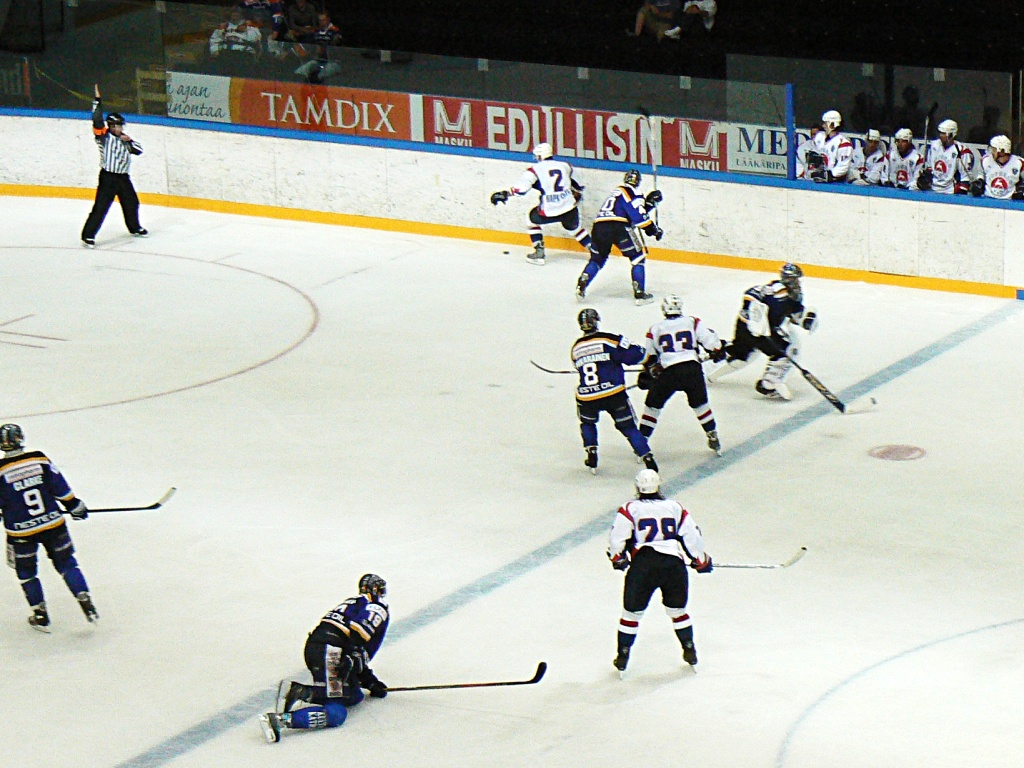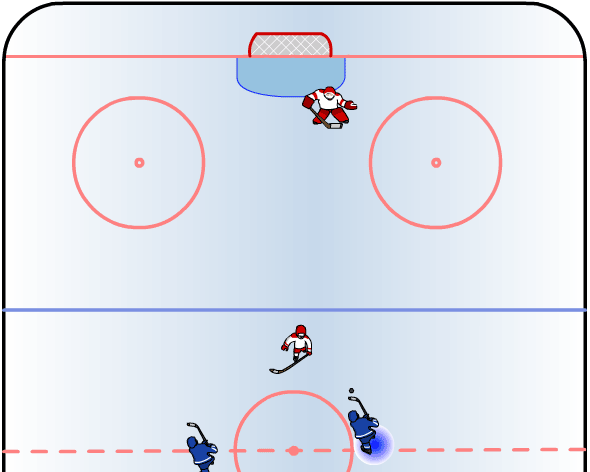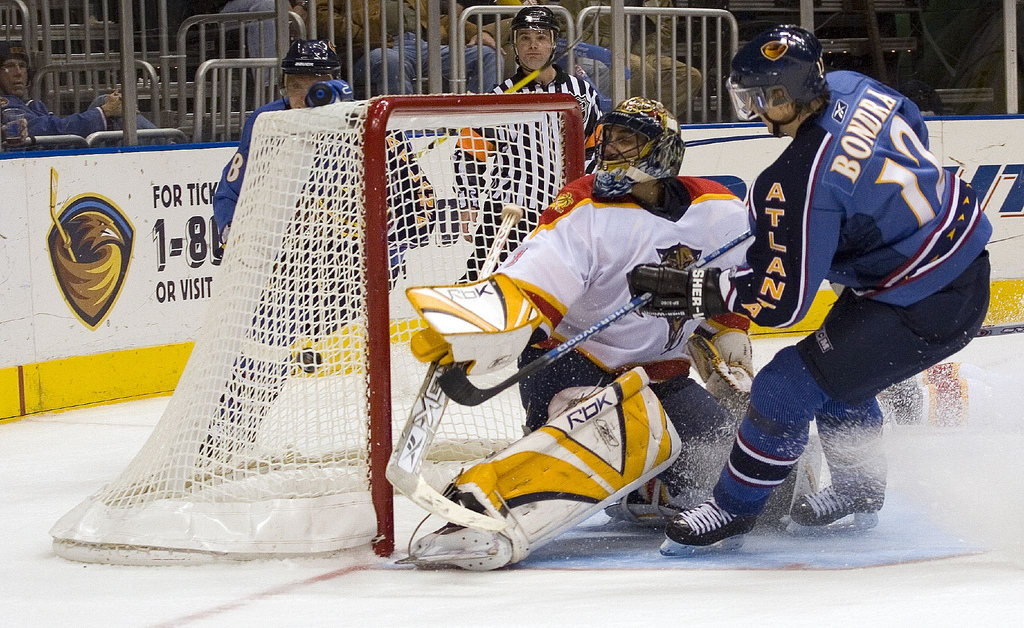|
Larry Mickey
Robert Larry Mickey (October 21, 1943 — July 23, 1982) was a Canadian professional ice hockey right winger who played in the National Hockey League (NHL) with the Chicago Black Hawks, New York Rangers, Toronto Maple Leafs, Montreal Canadiens, Los Angeles Kings, Philadelphia Flyers and Buffalo Sabres between 1965 and 1975. Playing career While playing with the Omaha Knights, Mickey was named to the first team of the Central Hockey League All-Stars during the 1966-67 season, and his team advanced to the Adams Cup finals that same year. On April 16, 1967, the night before the third game of the Adams Cup best-of-seven play-off series between the Omaha Knights and the Oklahoma City Blazers, Mickey was driving with his wife, Eleanor, on a country road near Seward, Nebraska late on Sunday night. The road's visibility was reduced to nearly zero as a result of blowing dust from a nearby field, and Mickey was involved in a two-car, head-on collision. Mickey suffered cuts, bruises and ... [...More Info...] [...Related Items...] OR: [Wikipedia] [Google] [Baidu] |
Winger (ice Hockey)
Winger, in the game of ice hockey, is a forward position of a player whose primary zone of play is along the outer playing areas. They typically flank the centre forward. Originally the name was given to forward players who went up and down the sides of the rink. Wingers generally have the least defensive responsibilities out of any position on the ice, however they are still tasked with defensive duties such as forechecking duties or covering the point in the defensive zone. Nowadays, there are different types of wingers in the game — out-and-out goal scorers, checkers who disrupt the opponents, and forwards who work along the boards and in the corners. Often a winger's precise role on a line depends upon what type of role the other winger plays; usually lines will have one more goal-scoring oriented winger and one winger more focused on playing the boards, checking and passing the puck to others to take shots (if a larger player, he will sometimes be called a "power forward ... [...More Info...] [...Related Items...] OR: [Wikipedia] [Google] [Baidu] |
Suicide
Suicide is the act of intentionally causing one's own death. Mental disorders (including depression, bipolar disorder, schizophrenia, personality disorders, anxiety disorders), physical disorders (such as chronic fatigue syndrome), and substance abuse (including alcoholism and the use of and withdrawal from benzodiazepines) are risk factors. Some suicides are impulsive acts due to stress (such as from financial or academic difficulties), relationship problems (such as breakups or divorces), or harassment and bullying. Those who have previously attempted suicide are at a higher risk for future attempts. Effective suicide prevention efforts include limiting access to methods of suicide such as firearms, drugs, and poisons; treating mental disorders and substance abuse; careful media reporting about suicide; and improving economic conditions. Although crisis hotlines are common resources, their effectiveness has not been well studied. The most commonly adopted metho ... [...More Info...] [...Related Items...] OR: [Wikipedia] [Google] [Baidu] |
Memorial Cup
The Memorial Cup () is the national championship of the Canadian Hockey League, a consortium of three major junior ice hockey leagues operating in Canada and parts of the United States. It is a four-team round-robin tournament played between the champions of the Ontario Hockey League (OHL), Quebec Major Junior Hockey League (QMJHL) and Western Hockey League (WHL), and a fourth, hosting team, which alternates between the three leagues annually. The Memorial Cup trophy was established by Captain James T. Sutherland to honour those who died in service during World War I. It was rededicated during the 2010 tournament to honour all soldiers who died fighting for Canada in any conflict. The trophy was originally known as the OHA Memorial Cup and was donated by the Ontario Hockey Association (OHA) in 1919 to be awarded to the junior ice hockey champion of Canada. From its inception until 1971, the Memorial Cup was open to all Junior A teams in the country and was awarded following a ... [...More Info...] [...Related Items...] OR: [Wikipedia] [Google] [Baidu] |
1962 Memorial Cup
The 1962 Memorial Cup final was the 44th junior ice hockey championship of the Canadian Amateur Hockey Association. The George Richardson Memorial Trophy champions Hamilton Red Wings of the Ontario Hockey League, Ontario Hockey Association in Eastern Canada competed against the Abbott Cup champions Edmonton Oil Kings (WCHL), Edmonton Oil Kings of the Central Alberta Hockey League in Western Canada. In a best-of-seven series, held at the Guelph Memorial Gardens in Guelph, Ontario, Kitchener Memorial Auditorium Complex, Kitchener Memorial Auditorium in Kitchener, Ontario, and the Barton Street Arena in Hamilton, Ontario, Hamilton won their 1st Memorial Cup, defeating Edmonton 4 games to 1. Schedule and scores Canadian Amateur Hockey Association (CAHA) president Jack Roxburgh announced the original schedule for the 1962 Memorial Cup with all games played at Maple Leaf Gardens and broadcast by CFTO-DT, CFTO-TV. The CAHA was threatened with legal action by K.D. Soble who owned both t ... [...More Info...] [...Related Items...] OR: [Wikipedia] [Google] [Baidu] |
Saskatchewan Junior Hockey League
The Saskatchewan Junior Hockey League is a Junior 'A' ice hockey league operating in the Canadian province of Saskatchewan and one of nine member leagues of the Canadian Junior Hockey League. Open to North American-born players 20 years of age or younger, the SJHL's 12 teams play in three divisions: the Olympic Buildings, Sherwood and Viterra Divisions. A major attraction in Saskatchewan, the SJHL draws 400,000 fans each season. The winner of the SJHL playoffs is crowned the provincial Junior A champion and continues on to play in the ANAVET Cup against the Manitoba provincial champion (winner of the Manitoba Junior Hockey League playoffs) for the right to represent the Western region at the Centennial Cup, the national Junior A championship. History The current version of the SJHL was preceded by a separate league with the same name that operated from 1948 to 1966. The modern SJHL was formed in July 1968 as a result of the Western Canada Hockey League (WCHL) splitting ... [...More Info...] [...Related Items...] OR: [Wikipedia] [Google] [Baidu] |
Moose Jaw Canucks
The Moose Jaw Canucks were a junior ice hockey team based in Moose Jaw, Saskatchewan, Canada. They were one of the founding members of the ''Western Canada Junior Hockey League'' (known today as the Western Hockey League) in 1966 following a rebellion within the Saskatchewan Junior Hockey League. The franchise evolved from the Moose Jaw Cubs in the early 1930s. The Canucks won the Abbott Cup in 1945 and 1947, making them the Junior "A" Champion for Western Canada and earning a playoff against the George Richardson Memorial Trophy winning Eastern Champion for the Memorial Cup. The Canucks lost their Memorial Cup competition against the Toronto St. Michael's Majors in both years. Franchise history The Canucks played in the following leagues in their history: *Prior to 1936: Independent schedule *1936–1946: Southern Saskatchewan Junior Hockey League *1946–1948: Saskatchewan Junior Hockey League *1948–1955: Western Canada Junior Hockey League *1958–1966: Saskatchewan Junio ... [...More Info...] [...Related Items...] OR: [Wikipedia] [Google] [Baidu] |
Penalty (ice Hockey)
A penalty in ice hockey is a punishment for an infringement of the rules. Most penalties are enforced by sending the offending player to a penalty box for a set number of minutes. During the penalty the player may not participate in play. Penalties are called and enforced by the referee, or in some cases, the linesman. The offending team may not replace the player on the ice (although there are some exceptions, such as fighting), leaving them short-handed as opposed to full strength. When the opposing team is said to be on a ''power play'', they will have one more player on the ice than the short-handed team. The short-handed team is said to be "on the penalty kill" until the penalty expires and the penalized player returns to play. While standards vary somewhat between leagues, most leagues recognize several common varieties of penalties, as well as common infractions. The statistic used to track penalties is called "penalty minutes" and abbreviated to "PIM" (spoken as single w ... [...More Info...] [...Related Items...] OR: [Wikipedia] [Google] [Baidu] |
Point (ice Hockey)
In ice hockey, point has three contemporary meanings. Personal stat A point is awarded to a player for each goal scored or assist earned. The total number of goals plus assists equals total points. The Art Ross Trophy is awarded to the National Hockey League (NHL) player who leads the league in scoring points at the end of the regular season. Team stat Points are also awarded to assess standings (or rankings). Historically, teams were awarded two points for each win, one point for each tie and no points for a loss. Such a ranking system, implemented primarily to ensure a tie counted as a "half-win" for each team in the standings, is generally regarded as British and/or European in origin and as such adopted by the National Hockey League which was founded in Canada where leagues generally used ranking systems of British origin. Awarding points in the standings contrasts with traditional American ranking systems favored in sports originating within the United States where today the m ... [...More Info...] [...Related Items...] OR: [Wikipedia] [Google] [Baidu] |
Assist (ice Hockey)
In ice hockey, an assist is attributed to up to two players of the scoring team who shot, passed or deflected the puck towards the scoring teammate, or touched it in any other way which enabled the goal, meaning that they were "assisting" in the goal. There can be a maximum of two assists per goal. The assists will be awarded in the order of play, with the last player to pass the puck to the goal scorer getting the primary assist and the player who passed it to the primary assister getting the secondary assist. Players who gain an assist will get one point added to their player statistics. Despite the use of the terms "primary assist" and "secondary assist", neither is worth more than the other, and neither is worth more or less than a goal. Assists and goals are added together on a player's scoresheet to display that player's total points. Special cases If a player scores off a rebound given up by a goaltender, assists are still awarded, as long as there is no re-possession by t ... [...More Info...] [...Related Items...] OR: [Wikipedia] [Google] [Baidu] |
Goal (ice Hockey)
In ice hockey, a goal is scored when the puck entirely crosses the goal line between the two goal posts and below the goal crossbar. A goal awards one point to the team attacking the goal scored upon, regardless of which team the player who actually deflected the puck into the goal belongs to (see also own goal). Typically, a player on the team attempting to score shoots the puck with their stick towards the goal net opening, and a player on the opposing team called a goaltender tries to block the shot to prevent a goal from being scored against their team. The term goal may also refer to the structure in which goals are scored. The ice hockey goal is rectangular in shape; the front frame of the goal is made of steel tube painted red (blue in the ECHL because of a sponsorship deal with GEICO) and consists of two vertical goalposts and a horizontal crossbar. A net is attached to the back of the frame to catch pucks that enter the goal and also to prevent pucks from entering it ... [...More Info...] [...Related Items...] OR: [Wikipedia] [Google] [Baidu] |
Season (sports)
In an organized sports league, a typical season is the portion of one year in which regulated games of the sport are in session: for example, in Major League Baseball the season lasts approximately from the last week of March to the last week of September. In other team sports, like association football or basketball, it is generally from August or September to May although in some countries - such as Northern Europe or East Asia - the season starts in the spring and finishes in autumn, mainly due to weather conditions encountered during the winter. A year can often be broken up into several distinct sections (sometimes themselves called seasons). These are: a preseason, a series of exhibition games played for training purposes; a regular season, the main period of the league's competition; the postseason, a playoff tournament played against the league's top teams to determine the league's champion; and the offseason, the time when there is no official competition. Preseason In ... [...More Info...] [...Related Items...] OR: [Wikipedia] [Google] [Baidu] |
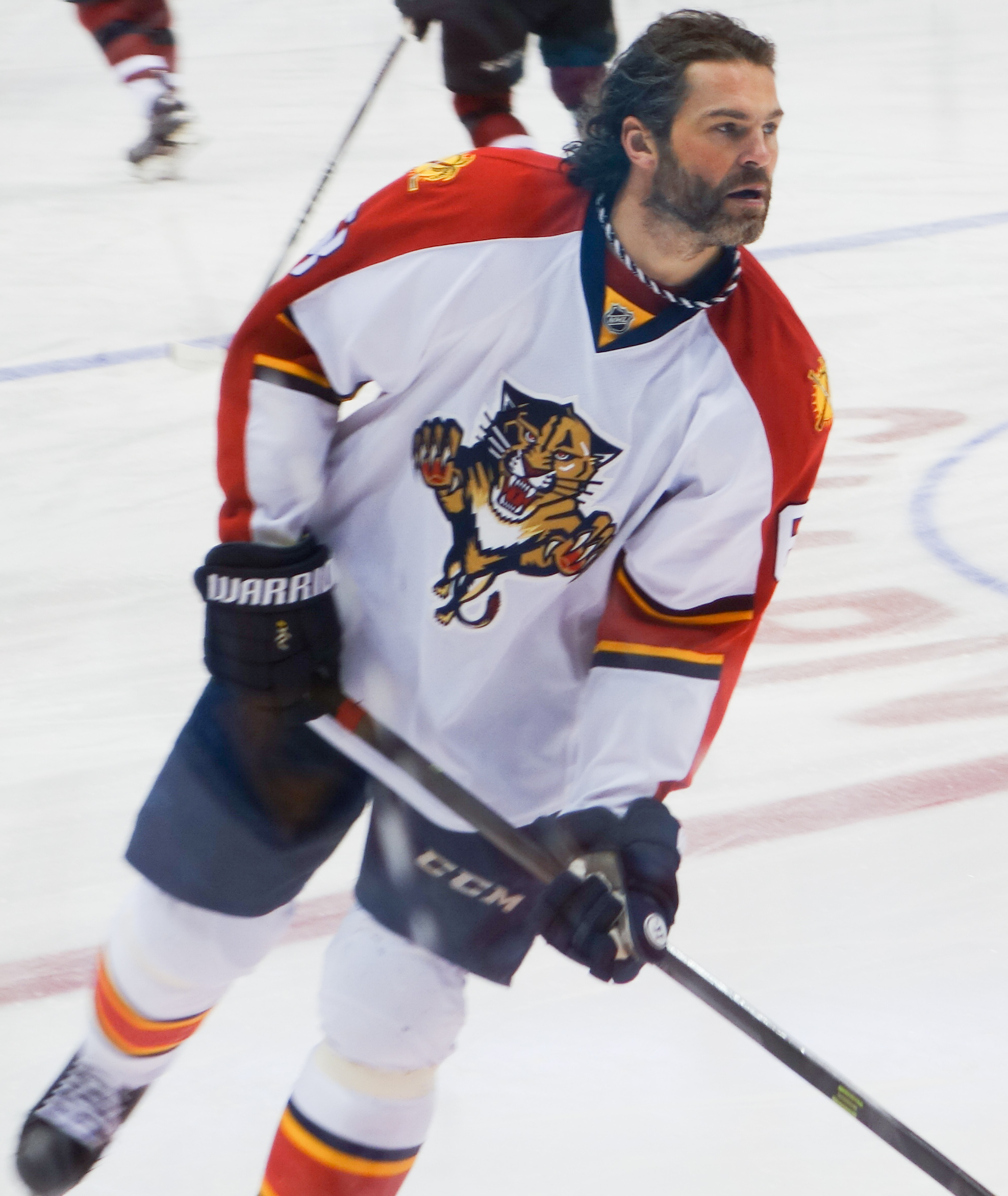
.jpg)

